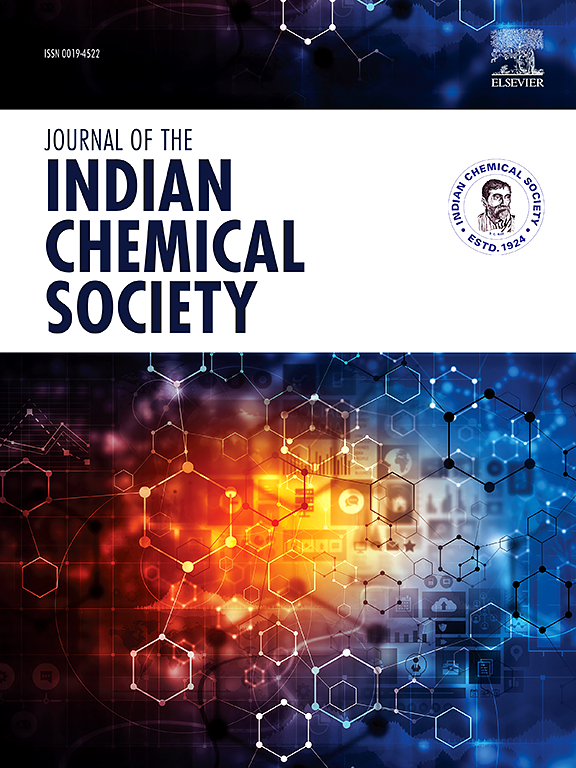掺铒对Mg-Co纳米铁氧体的影响:结构、光学、弹性、电学和磁学性能的研究
IF 3.2
4区 化学
Q2 CHEMISTRY, MULTIDISCIPLINARY
引用次数: 0
摘要
采用柠檬酸凝胶自燃烧法制备了一系列Er3+掺杂的镁钴纳米铁氧体,其通式为Mg0·8Co0.2ErxFe2-xO4(0、0.02、0.04、0.06、0.08、0.1 mol%)。x射线衍射(XRD)分析证实,所有合成样品均形成立方尖晶石结构。从XRD数据中得到了结构参数,如晶格常数、x射线密度和阳离子分布。利用扫描电子显微镜(SEM)研究了纳米铁氧体的表面形貌,并用能量色散x射线能谱(EDS)证实了所有预期组成元素的存在。傅里叶变换红外光谱(FTIR)显示出不同的吸收带(ν1和ν2)对应于四面体和八面体位点,证实了铁氧体的结构。Er3+的掺杂显著影响了材料的几个参数。关键的弹性性能,包括德拜温度、体积模量和刚度模量,都是通过FTIR数据计算出来的。由于掺入而增强的原子间键导致弹性模量的提高,突出了掺杂剂对结构特性的强烈影响。磁性表征表明,随着Er3+含量的增加,饱和磁化强度(Ms)和剩余磁化强度(Mr)逐渐降低,表明磁性强度降低。磁滞回线分析表明,随着矫顽力(Hc)的增加,铁磁表现为软磁。当Er含量为0.10时,最小饱和磁化强度为26.348 emu/g。方形比值表明样品呈现单畴特征,符合软铁磁行为。介电光谱显示麦克斯韦-瓦格纳界面极化,在固定温度下,极化随频率(20 Hz-1 MHz)的增加而减小。对样品进行了阻抗、电模量、介电常数、损耗正切(tanδ)和交流电导率的综合分析。每种成分的介电损耗正切值都保持在最佳范围内,表明这些铁氧体材料具有多层电感芯片和新型微波器件应用的潜在适用性。本文章由计算机程序翻译,如有差异,请以英文原文为准。

Effect of erbium ion doping on Mg–Co nano ferrites: A study on structural, optical, elastic, electric and magnetic properties
A series of Er3+-doped magnesium cobalt nano ferrites with the general formula Mg0·8Co0.2ErxFe2-xO4 (0, 0.02, 0.04, 0.06, 0.08, and 0.1 mol%) were successfully synthesized using the citrate gel auto-combustion method. X-ray diffraction (XRD) analysis confirmed the formation of a cubic spinel structure in all synthesized samples. Structural parameters such as lattice constant, X-ray density, and cation distribution, were derived from the XRD data. The surface morphology of the nano-ferrites was investigated using scanning electron microscopy (SEM), while energy-dispersive X-ray spectroscopy (EDS) confirmed the presence of all expected constituent elements. Fourier transform infrared spectroscopy (FTIR) revealed distinct absorption bands (ν1 and ν2) corresponding to tetrahedral and octahedral sites, confirming the ferrite structure. Er3+ doping significantly influenced several material parameters. Key elastic properties, including Debye temperature, bulk modulus, and stiffness modulus, were calculated from FTIR data. The enhanced interatomic bonding due to incorporation resulted in improved elastic moduli, highlighting dopants strong impact on the structural characteristics. Magnetic characterization showed a gradual decrease in both saturation (Ms) and remanent (Mr) magnetization with increasing Er3+ content, indicating a reduction in magnetic strength. Hysteresis loop analysis revealed soft ferromagnetic behavior with increasing coercivity (Hc). The minimum saturation magnetization was observed at 26.348 emu/g for the sample with 0.10 Er content. The squareness ratio values suggested that the samples exhibit single-domain characteristics, consistent with soft ferromagnetic behavior. Dielectric spectroscopy demonstrated Maxwell Wagner interfacial polarization, evidenced by a decreasing polarization trend with increasing frequency (20 Hz–1 MHz) at a fixed temperature. A comprehensive analysis of impedance, electric modulus, dielectric constant, loss tangent (tanδ), and AC conductivity were performed for the samples. The dielectric loss tangent values for each composition remained within an optimal range, indicating the potential suitability of these ferrite materials for multilayer inductor chip and novel microwave device applications.
求助全文
通过发布文献求助,成功后即可免费获取论文全文。
去求助
来源期刊
CiteScore
3.50
自引率
7.70%
发文量
492
审稿时长
3-8 weeks
期刊介绍:
The Journal of the Indian Chemical Society publishes original, fundamental, theorical, experimental research work of highest quality in all areas of chemistry, biochemistry, medicinal chemistry, electrochemistry, agrochemistry, chemical engineering and technology, food chemistry, environmental chemistry, etc.

 求助内容:
求助内容: 应助结果提醒方式:
应助结果提醒方式:


